|
61 The Strand
Deal
01304 372201
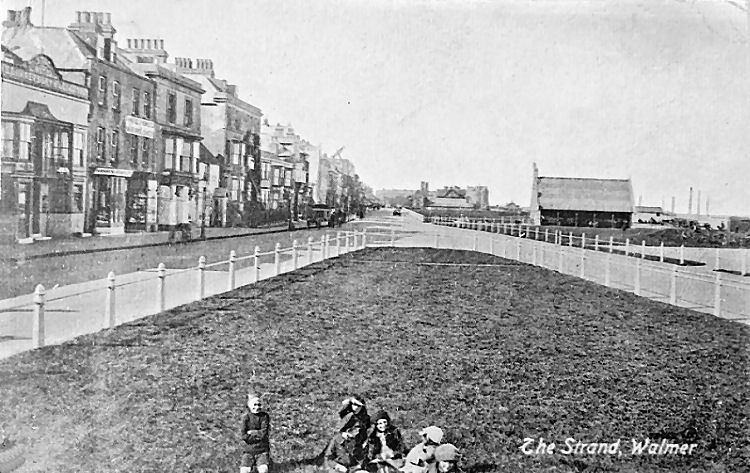
Above postcard 1914, kindly sent by Rory Kehoe. Shown extreme left. |
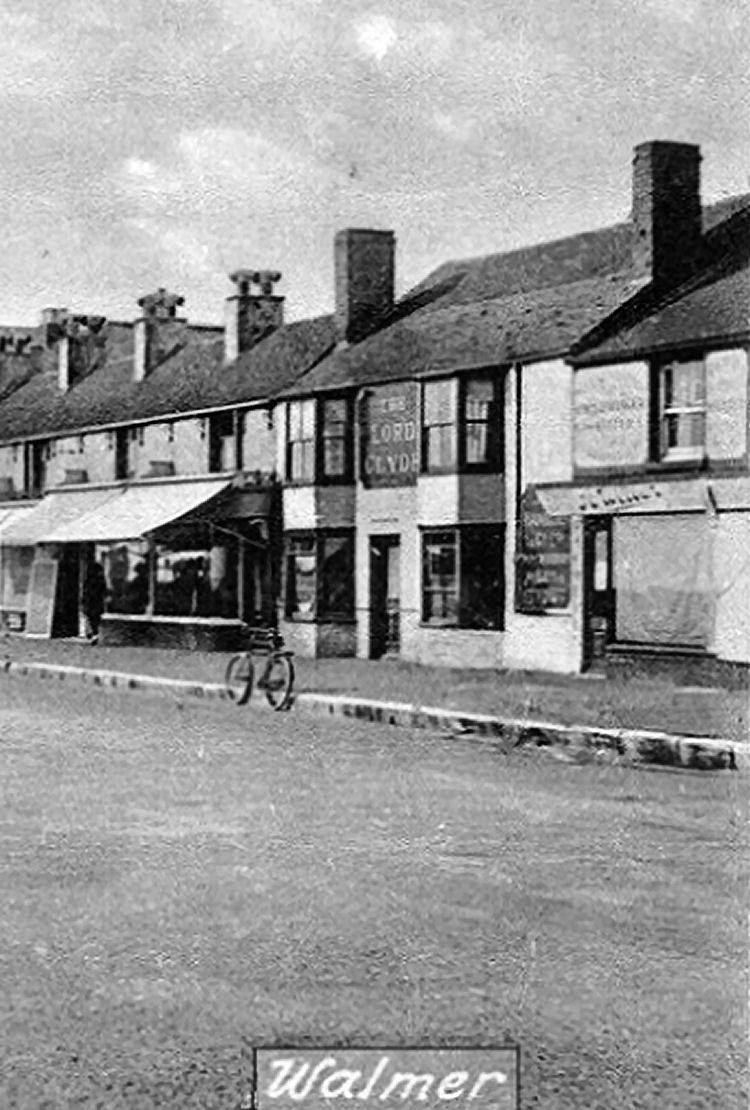
Above photo, circa 1923, kindly sent by Rory Kehoe. |
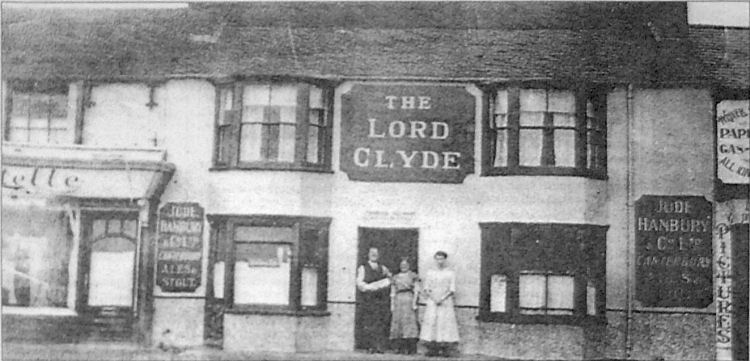
Above shows the Lord Clyde 1925 with licensee Thomas Hilson and family at the door. |
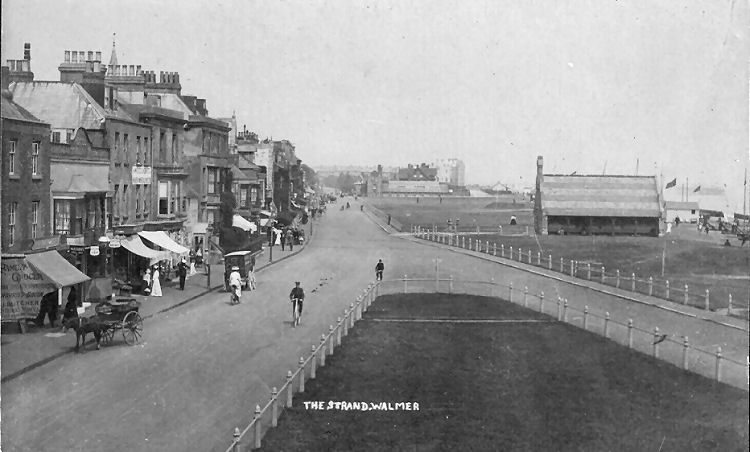
Above postcard circa 1904, kindly sent by Rory Kehoe. |
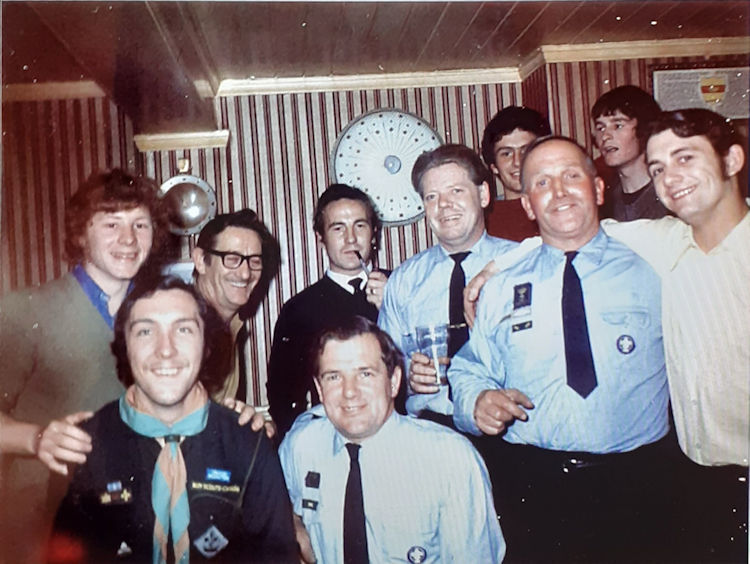
Sent by Charlie Horne.
During the late 1960s and 1970s, on a Friday night, the local Scout
Leaders could often be found enjoying a well-earned pint in the "Lord
Clyde" on the Strand. Numbers would be anything from 3 to 20 depending
on who was nearby at the time and fancied a chat!
This photo, inside the "Clyde," dates from around 1972-73 and
features several local scouters plus one Belgian Scout Leader visiting
from Antwerp Sea scouts. 2nd Deal Sea Scout Leaders Jock Milne and
Harold "Skip" Mercer are there, along with a young 1st Deal (Walmer)
leader Charlie Horne on the left, and Bill Holman from 10th Deal (Eastry)
Scouts in the glasses. Also Alan Coller and Peter Marsh from 5th Sholden
Scouts standing behind Skip Mercer. A big thank you to Steve Milne for
providing this great photo from his late father's collection. |
|
From the East Kent Mercury 8 December 2011
Lord Clyde history feature
update
I REFER to your article about the Lord Clyde on November 24 in the Now
and Then feature.
I believe the caption you had regarding 1900 to be incorrect. My grandad,
Thomas Hilson, had the "Lord Clyde," certainly after the First World War
and sometime in the 1920s, and the book Old Pubs of Deal and Walmer
(with Kingsdown and Mongeham) by Steve Glover and Michael Rogers quotes
him being there in 1923.
The photo is of him and his wife but I am not sure who the other female
is.
He had three sons and it is probably his wife's sister, who may have
helped in the pub.
John Hilson, Blake Close, Walmer
|
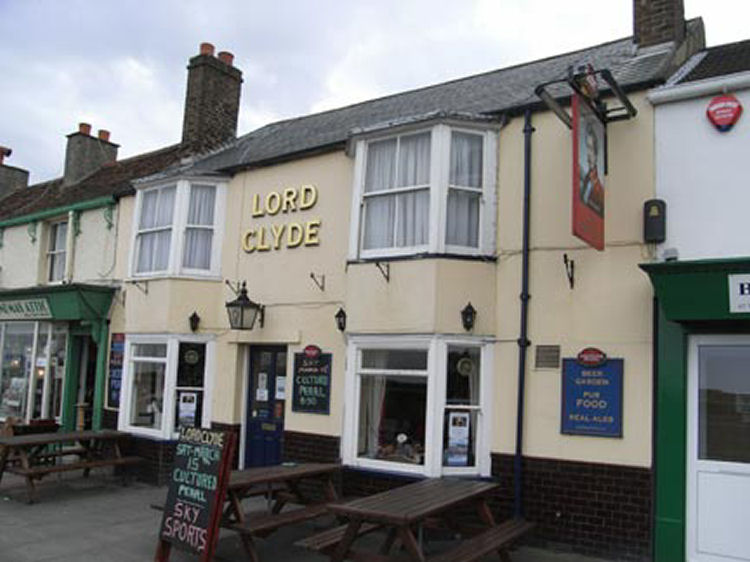
Above photo kindly sent by licensee Paul White, 22 March 2010. |
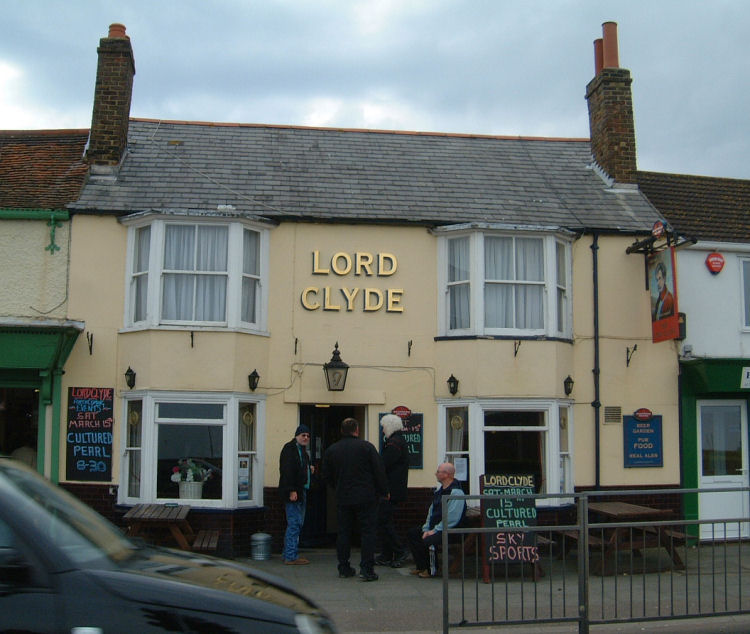
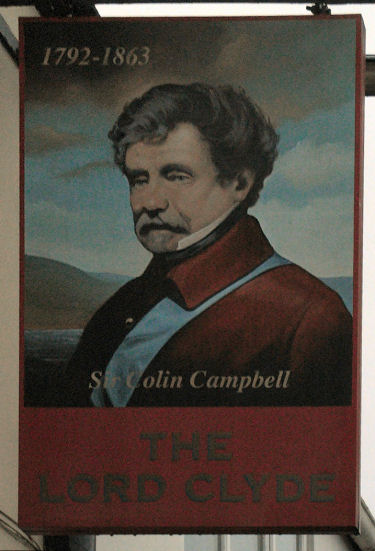 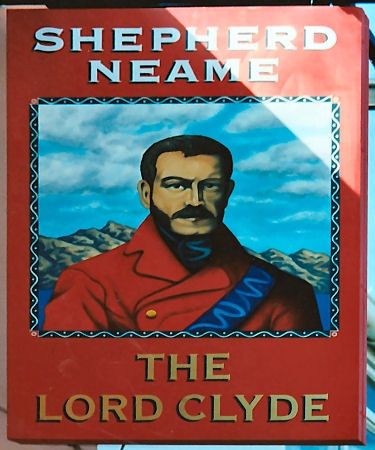
Above sign left, 2011 by Tony Wells, sign right, August 1992.
With thanks from Brian Curtis
www.innsignsociety.com.
|
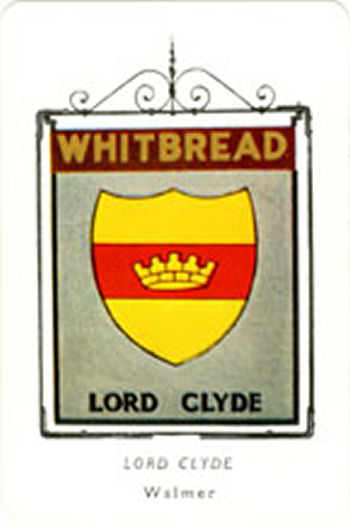
Above aluminium card issued June 1951. Sign series 3 number 20. |
Earliest found to date is the 1861 census that suggests the pub was
operating around 1860. Further information tell me the pub was built and
opened in 1858.
Named after 1st Baron Clyde, also known as Field Marshall Colin Campbell
(1892-1863) he was a British soldier of Scottish origin, born Colin Macliver
he took his name from his mother's brother Colonel John Campbell, when only
15 he was presented to the Duke of York who enlisted him under the surname
Campbell.
The following has kindly been sent to me from Mark Frost, ex Senior
Assistant Curator at Dover Museum, taken from deeds held at the museum.
In 1858 Walmer Builder John Holtum built the "Sir
Colin Campbell" pub and the Lord Clyde pub, Clyde being the peerage
title of Campbell. In October 1858 Holtum sold the "Sir
Colin Campbell" and Lord Clyde to James and Rachel Knight of Milstead,
Kent. The Knights moved into the "Sir
Colin Campbell" and rented out the Lord Clyde
James Knight, licensed victualler of the "Sir
Colin Campbell" in Walmer, died 24th March 1862.
John Wyborn and Andrew Gilehurst were the first tenants when they
purchased the pub in 1858. When Knight died in 1862, their tenant at the
Lord Clyde was William Romney, whom Rachel married on 28th April 1866.
Rachel moved to the Lord Clyde and the Romneys signed a new 10-year lease of
the "Sir Colin Campbell" to John
Matthews from 11th October 1867.
On 15th October 1869 the Romneys mortgaged the "Sir
Colin Campbell" and cottages and the Lord Clyde to William Henry Solly,
a sum of of £108.17.0 paid directly to Morris Bowles Thompson to repay a
debt due to him by Romney and an additional sum of of £360 to the Romneys.
On 8th February 1870 this last sum of £360 was transferred to a mortgage
with Richard Joynes Emmerson.
In early 1878 the Romneys agreed to separate and end their marriage due
to differences and to live apart, William to pay his wife £26 per annum.
On 9th February 1880 a deed of separation was signed between William
Romney, now a coachman, and Rachel his wife, late Rachel Knight, widow.
William Romney died 2nd July 1882.
On 3rd April 1884 Rachel Romney of 2 Duke Street, Deal, sold to
Thompson's Brewery of Walmer, the leasehold pub the "Sir
Colin Campbell" for the remainder of the lease from the Leith Estates of
36 years, ground rent £2.5.0 p.a., for the sum of £700.
Rachel retained the Lord Clyde which she leased out to the East Kent
Brewery Company on a 21 year lease from 6th July 1884 at £35 per annum,
George Henry Cotton Stapleton their tenant.
Rachel Romney of 2 Farrier Street, Deal, died 26th June 1886. In her will
she instructed her executor, son William Romney, to sell the Lord Clyde at
Lower Walmer when her youngest daughter Bertha Mary reached the age of 18,
the proceeds then to be divided between her four Romney children William,
Ada, Julia and Bertha Mary. Under the Kent system of Gavelkind, the three
sons of Rachel had to formally agree to this - Walter Frederick Knight,
James Thomas Gooch Knight and William Romney, her sons and heirs in
gavelkind. They instructed William Romney as executor to sell the Lord Clyde
and 2 Farrier Street.
On 30th July 1891 the Lord Clyde beer house of the Strand, Lower Walmer
and 2 Farrier Street, Deal, were sold at auction - the Lord Clyde then
leased to the East Kent Brewery Company was sold to to John Barnett Joyce of
Sandwich, brewer, as agent for William Pitt Draffen of London (the manager
and the owner of EKB Co respectively) for £550.
Many thank to Mark Frost for the above.
|
From the Kentish Chronicle, 19 April, 1862.
Catherine Kane, who was only liberated from gaol on Saturday, was
charged with creating a disturbance at the “Lord Clyde” public-house,
Military Road.
Mr. Russell, the landlord, deposed that the defendant came into his tap
room, on Saturday night, and asked for a pot of beer. Both himself and
his wife refused to serve her, and as the complainant was endeavouring
to turn her out, she struck him several times. He then gave information
to the police, but the officer communicated with said, that as he had
not seen any of the disturbance he did not think he should be justified
in apprehending her. About half an hour after she returned to the house,
and was again very violent. She threw two pots down, and when
complainant attempted to put her out she again assaulted him.
Committed for a month to the city gaol.
|
|
From the Deal, Walmer, and Sandwich Mercury,
11 September, 1869. 1d.
ANNUAL LICENSING DAY
The renewal of the license of Mr. Romney, the landlord of the "Lord
Clyde" beer-house was opposed by the Superintendent of Police. Mr.
Mourilyan, who supported the renewal, however, produced a memorial,
signed by the neighbours, setting forth the good character of the
landlord, and that the house was no annoyance to them, and also one
signed by some gentleman in the neighbourhood, also testifying to his
good character; and stated that Mr. Romney had lived many years in the
service of the late Sir N. Knatchbull, also with Colonel Rae and other
gentleman of position. The Magistrates immediately renewed the license.
|
|
Whitstable Times and Herne Bay Herald, 1 January 1870.
CANTERBURY POLICE COURT.
Thursday. (Before the Mayor, and W. J. Cooper, Esq).
PUBLICAN'S OFFENCE.
Mrs Russell, landlady of the “Lord Clyde," was charged with opening her
house for the sale of beer at an illegal hour on Sunday, the 26th. The
evidence of P.C. Tomlin went to show that there were several people in
the house, who were very noisy. The doors were closed.
The Mayor pointed out an informality in the wording of the summons.
Defendant was charged with opening her house, whereas it was closed.
The Magistrates' Clerk: Yes, if I had received proper information, the
summons would have been differently worded, viz, the defendant would
have been charged with selling beer at an illegal time.
The Superintendent thought that when the doors were not fastened and
business was going on, the house was opened.
The Bench however dismissed the case, but expressed an opinion that
Tomlin had done his
duty.
|
The pub was supplied by Jude Hanbury of Canterbury at the turn of the 19th century.
By 1924 the pub was supplied by the East Kent brewery who advertised the
premises as including a beerhouse with stabling. Mackeson's took over later
and in January 1841 placed a protection order on the building. An outlet for Fremlins in 1974.
 and after this saw Shepherd Neame take over the building and it it these
today who still supply the beer.
and after this saw Shepherd Neame take over the building and it it these
today who still supply the beer.
The licensee Herbert Hilson eventually moved next door and opened Dainties Sweet
Shop round about 1900 and in 1923 another Hilson was licensee. At present it
is unknown whether they were related..
The "Alma" used to stand close
by but now unfortunately closed.
|
From "Inns of Kent"; Whitbread & Co. Ltd.; 1948.
Deal and Walmer are contiguous and there is little to choose between
them. Both are graced with one of Henry VIII's charming but businesslike
clover-leaf castles (that of Walmer is the official residence of the
Lord Warden of the Cinque Ports), and both have played a great part in
the medieval history of England. The sea fronts are architecturally
enchanting, with every known period represented, but mainly Georgian and
early Regency. The "Stag" at Walmer and The
"Lord Clyde" are both good
Regency houses within a few yards of one another, facing the sea, just
waiting for history to turn another page. From without one catches the
cheerful glint of a well-polished tap room, for quiet comfort is the
keynote of them both. Only, at some time or another, The "Stag" has stolen
a march on The "Lord Clyde" and has produced a neat little Regency balcony
with canopy complete, which seems hardly fair.
|
|
From an Email received 1 January 2011
I am just researching family
history and found in 1881 Census that my Great Great Grandfather William
Thomas Bullen is listed as a Licensed Victualler for The Lord Clyde,
Walmer Kent in 1881.
Photo of him shown below supplied by Ken Paul, his Great, Great
Grandson.
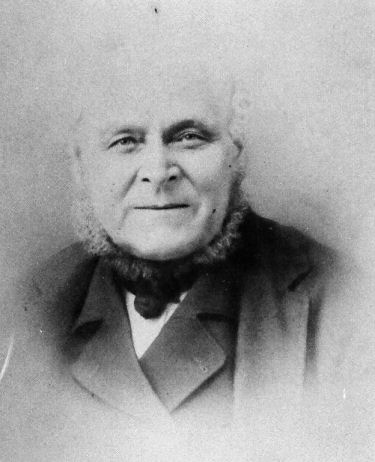
Have sent for his will – had 70 pounds left to his son who is also
listed as a Licensed Victualler in 1896 when he died. He was licensee
from at least 1874 till at least 1891 when he retired, he died in 1896.
So will see if his son took it over when he died. His son, however,
was licensee of the "Dolphin" from
1878 to 1908.
I am currently going through all other census years to see what/who
was at the address 59 – 61 The Strand, Lord Clyde.
Regards, Marie Grech
Doubleview, Perth, Western Australia.
|
|
From the East Kent Mercury 16 August 1990.
SAYING CHEERS TO PHIL.
Phil Bailey has pulled his last pint at The "Clyde" in Walmer and
left the pub after nearly eight years behind the bar.
Customers have been saying goodbye to Phil and his wife Cindy and a
series of presentations were organised.
An official Royal Marines School of Music picture was handed over by
regulars from the barracks, and staff from the National Westminster
Bank, along The Strand, gave Phil an iced cake.
|
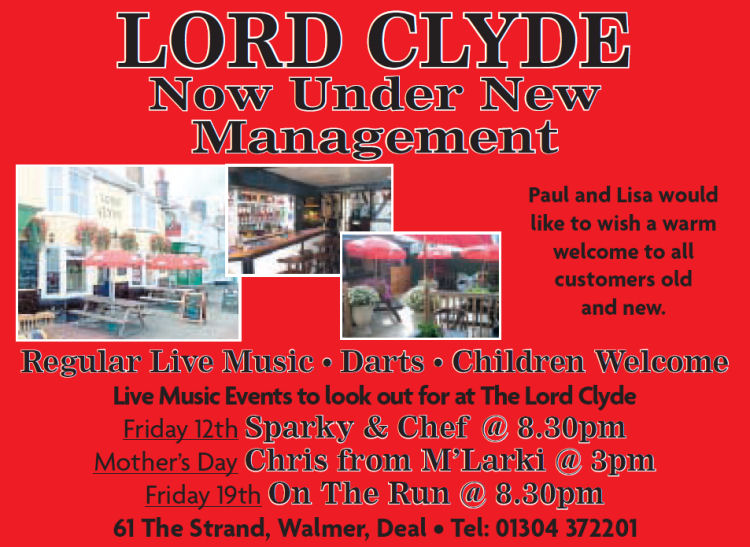
Above shows an advert that appeared in the Deal Mercury 2010
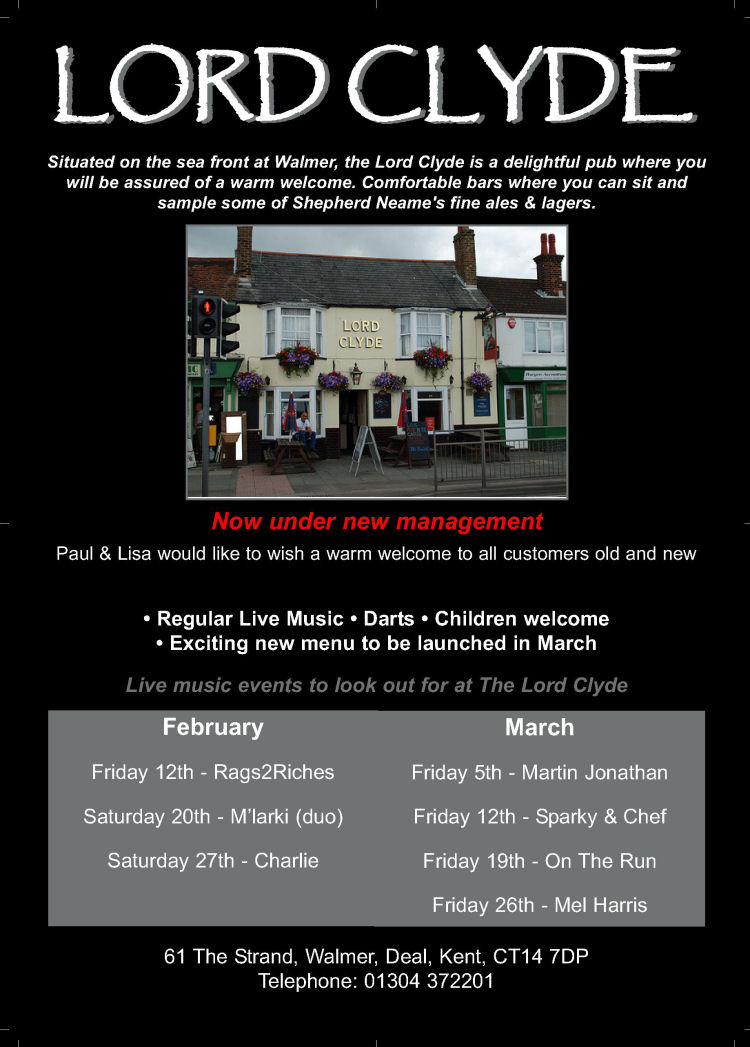
Above shows an advert that appeared in the Deal Gig Guide 2010. |
I have just been informed that the pub was closed in the latter part of
2010.
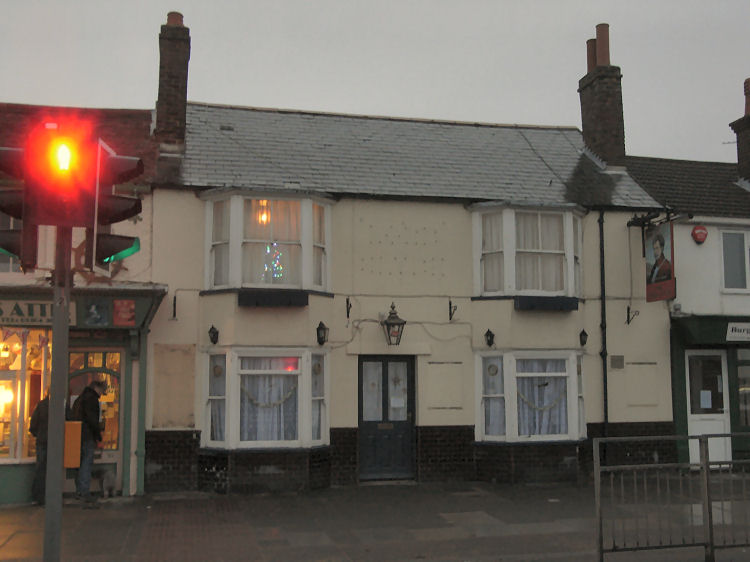
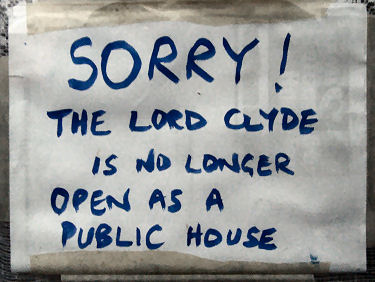
Sign shows the information seen in the window, January 1st, 2011,
both photos taken by
Tony Wells. |
|
From Porters Chartered Surveyors 1 January 2011
THE LORD CLYDE, 61 THE STRAND, WALMER, DEAL, KENT CT14 7DP
Freehold Guide Price: £220,000 PLUS VAT PLUS SAV
Prominent on Walmer Strand overlooking seafront. Easily managed,
attractive one bar community public house with food potential. Single bar
with central bar servery, trade kitchen, customer toilets, cellar. Three
bedroom private accommodation plus lounge, kitchen and bathroom. Rear trade
garden with covered smoking shelter.
Ref: PA451
|
|
From the Dover Mercury, 24 November, 2011.
70p
RICH HISTORY OF LORD CLYDE PUB
The Strand is one of the town's best assets, with its historic
lifeboat house, St Saviour's Church, the line of beach huts, boats and
the Deal Memorial Bandstand on Walmer Green. Many shops have been
converted into homes, although many are still in business along the long
row of properties overlooking the sea.
There also used to be plenty of pubs, but now only one remains, which
is the "Stag."
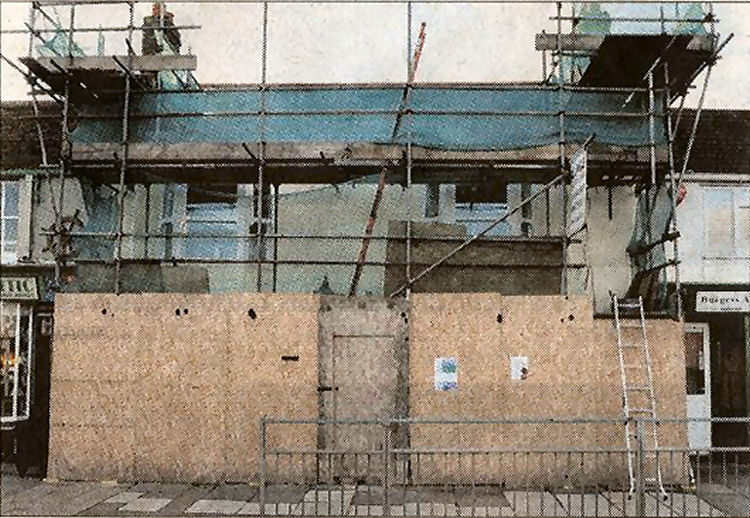
Scaffolding is up around the former "Lord Clyde" opposite Walmer
Paddling Pool, which closed about a year ago. There are plans to convert
it into a restaurant.
The pub was named after "Lord Clyde," who was born Colin Campbell in
Glasgow in 1792 and died In 1863.
He was an outstanding soldier,
and as a young recruit adopted his uncle's name. He saw action in the
Peninsular War between 1808 and 1814 and was stationed in Gibraltar,
Barbados, China and India, honoured for his bravery with a knighthood
and a sword of honour presented by the city of Glasgow.
He was commander-in-chief
in India at the time of the Indian Mutiny and brought about the relief
of Lucknow. He was promoted to the rank of Field Marshall on his return
to Britain. He was buried in Westminster Abbey.
The "Lord Clyde" beer house opened about 1860 and in 1870 the landlord was
imprisoned for six months' hard labour for beating his wife.
According to The Old Pubs
of Deal and Walmer (with Kingdown and Ringwould), the East Kent Brewery
in 1923 advertised the premises as a "beer house and stabling".
From
1924 through to the
1940s it was considered to be a cosy family pub with ex-Royal Marine
bandsman Billy Monckton in charge.
He was still behind the bar when the "Lord Clyde" was granted a wine
licence, followed by a full licence in 1950.
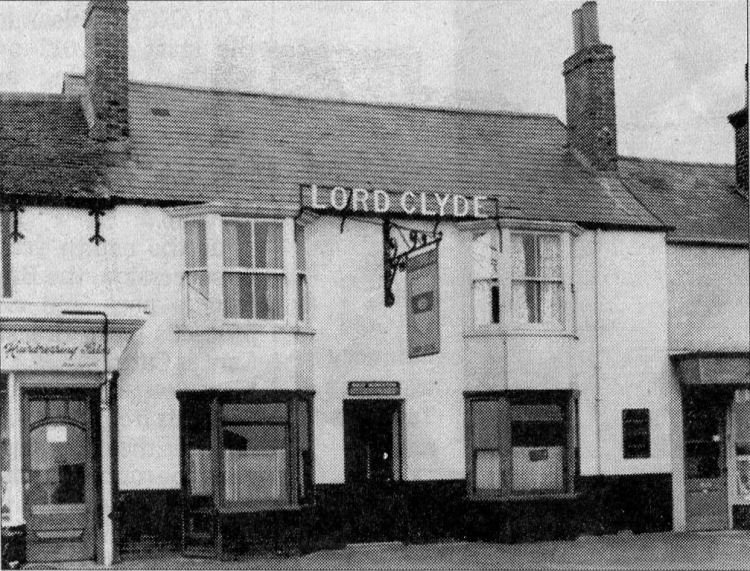
Shepherd Neame took over
the premises in 1971 and in the early 1970s the landlady was Ellen Pickford, a life-tong fan of comedian Max Wall, who is said to have
visited the pub.
The Old Pubs of Deal and Walmer (with Kingsdown and Mongeham) was
written by Steve Glover and Michael Rogers, who both live in Deal. It was
first published by Bygone Publishing, Whitstable.
A hardback version was
on sale last year and the book is now on sale as a paperback for £15.99
from Tylers and Ropers in Deal High Street and also Deal Book Shop in
Broad Street.
|
|
From the East Kent Mercury 8 December 2011
Last orders by Steve Glover and Michael Rogers.
The "Lord Clyde" opened around 1861. In the first half of the 20th
century, it was run by Billy Monkton and his wife, together with a ‘fish
supper saloon' in York Road, which was accessed via the rear of the pub. In
1963, The Rolling Stones performed a gig at the Strand Palais in The "Yew
Tree," in Mill Hill North Barrack Road (which was previously a pub called
The "Rising Sun" but now an Autobase Cyclelife outlet).
The story goes that Mick Jagger and Brian Jones popped into the "Lord
Clyde" for a drink but were forcibly ejected following an altercation! The
pub called ‘last orders' in December 2010 and the building is currently
undergoing renovations and will soon reopen as La Bouche, a French
restaurant.
|
Latest news is the pub is indeed being transformed into a French
Restaurant titled "La Bouche." Details regarding when it will open are to
follow, and will probably be published in their own web site found here:- www.la-bouche.co.uk
(link no longer active 2019)
|
From the Dover Express, Thursday, 8 March, 2012. 60p. Report by Sam Inkersole
NEW RESTAURANT IS A LIFELONG DREAM
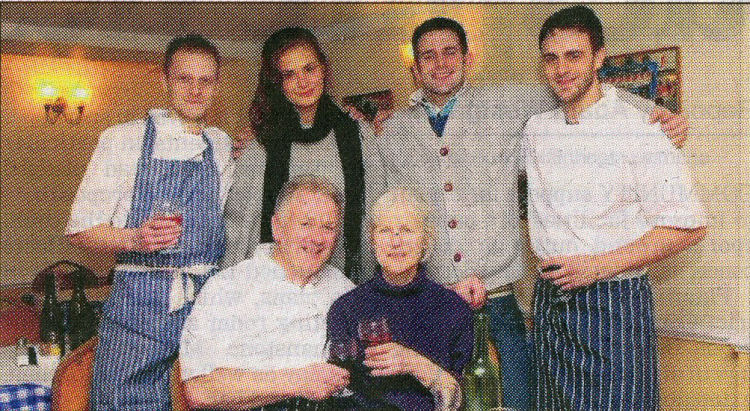
VIVE LA FRANCE: Peter May, his wife Jane, head chef and son Henry with
staff at their new restaurant, La Bouche.
French cuisine on the menu at former pub
A NEW restaurant opened in Walmer on Tuesday, the realisation of the
owner's lifelong dream.
"La Bouche," a French restaurant on The Strand, on the site of the old
"Lord Clyde" pub, is the brainchild of Pete May.
Mr May, 59, bought the pub when it closed down 16 months ago, and has
completely refurbished the building.
The father-of-one also runs a small residential home in Dover, but says
he has been dreaming up a fantasy French menu for the last 35 years.
Now he has taken the plunge and opened his own restaurant, and says he
can't wait to get going.
He said: “It has taken twice as long and twice the amount of cash we had
planned to refurbish the old pub, but we are finally at a stage where we
can open.
“This is a realisation of a 35-year dream, and to have my family as part
of this venture makes
me immensely proud.
“Having worked in social services and residential homes throughout my
professional career, I want visitors to the restaurant to come not just
for the excellent food, but to also be looked after properly and treated
well in a friendly atmosphere.
“The pub was in a terrible state when we took it over. But after a
lot
of hard work we have transformed it and it looks great.
“Before my mum passed away two years ago she said to me that I should
follow my dream and open a restaurant, and here I am now.
Mr May paid tribute to his wife Jane, son Henry and step-daughter Nicky
for helping to get the project off the ground.
He added: “I could not have done it without them and all their help over
the last 16 months.
■ To make a booking at La Bouche, call 01304 368881.
|
Latest news I have just received in November 2016 is that Eva and Steve
Whitney have just bought the building and have opened it up as a French
restaurant or Fish Resturant called "Whits of Walmer."
|
From the
http://www.bbc.co.uk By Soutik Biswas, 5 April 2018.
What a skull in an English pub says about India's 1857 mutiny.
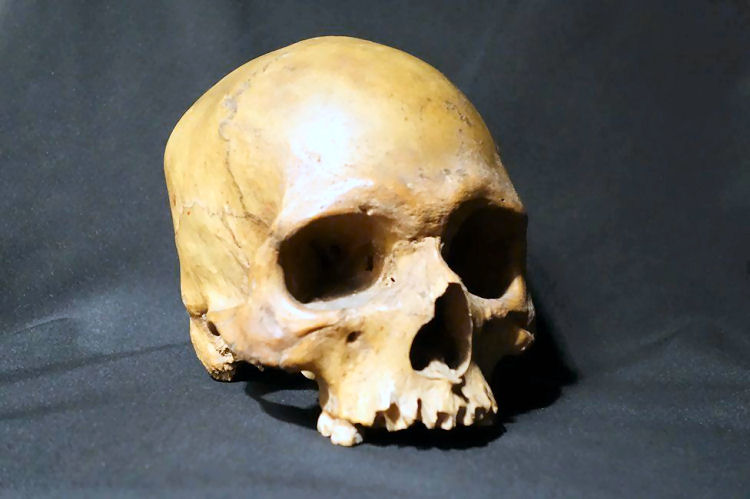
The skull belonged to a 32-year-old Indian soldier who revolted against the British.
In 2014, while sitting in an office in London's Mile End, historian
Kim Wagner received an email from a couple who said they owned a
skull.
Dr Wagner, who teaches imperial history at Queen Mary University of
London, says the couple told him they did not feel comfortable with
the "thing" in their house, and did not know what to do with it.
The lower jaw of the skull was missing, the few remaining teeth were
loose, and it had the "sepia hue of old age".
But what was remarkable was a detailed handwritten note in a neatly
folded slip of paper inserted in an eye socket. The note told the
brief story of the skull:
Skull of Havildar "Alum Bheg," 46th Regt. Bengal N. Infantry who was
blown away from a gun, amongst several others of his Regt. He was a
principal leader in the mutiny of 1857 & of a most ruffianly
disposition. He took possession (at the head of a small party) of
the road leading to the fort, to which place all the Europeans were
hurrying for safety. His party surprised and killed Dr. Graham
shooting him in his buggy by the side of his daughter. His next
victim was the Rev. Mr. Hunter, a missionary, who was flying with
his wife and daughters in the same direction. He murdered Mr Hunter,
and his wife and daughters after being brutally treated were
butchered by the road side.
Alum Bheg was about 32 years of age; 5 feet 7 ½ inches high and by
no means an ill looking native.
The skull was brought home by Captain (AR) Costello (late Capt. 7th
Drag. Guards), who was on duty when Alum Bheg was executed.
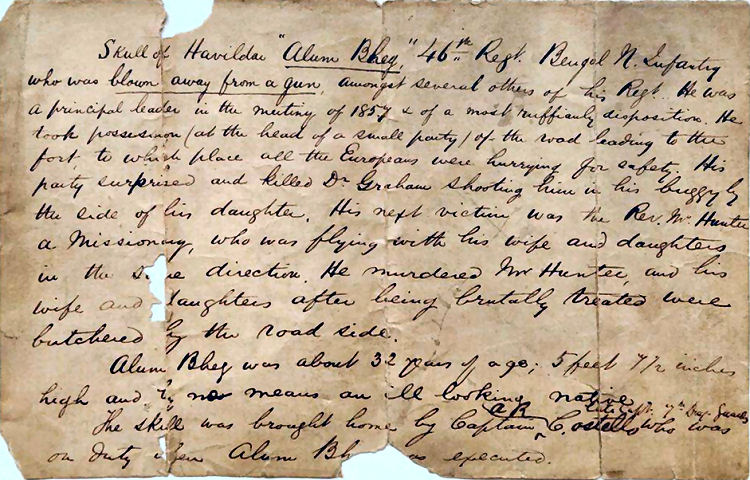
A handwritten note inserted in an eye socket told the brief story of
the skull.
What was clear from the note was that the skull was of a rebel
Indian soldier called Alum Bheg, who belonged to the Bengal Regiment
and who was executed in 1858 by being blown from the mouth of a
cannon in Sialkot (a town in Punjab province located in present-day
Pakistan); and that a man who witnessed the execution brought the
skull to England. The note is silent on why Bheg committed the
alleged murders.
Native Hindu and Muslim soldiers, also known as sepoys, rebelled
against the British East India Company in 1857 over fears that gun
cartridges were greased with animal fat forbidden by their
religions. The British ruled India for 200 years until the country's
independence in 1947.
The couple in Essex had trawled the internet and failed to find
anything about Bheg. They contacted Dr Wagner after they found his
name as a historian who had authored a book on the Indian uprising,
often referred to as the first war of independence.
'Grisly trophy'
On a wet November day, which was also his birthday, Dr Wagner met
the couple. They told him that they had inherited the skull after
one of their relatives took over a pub in Kent called the "Lord Clyde"
in 1963, and found the skull stored under some old crates and boxes
in a small room in the back of the building.
Nobody quite knows how the skull ended up in the pub. The local
media had excitedly reported on the "nerve-shattering discovery" in
1963 and carried pictures of the new pub owners "proudly posing with
the grisly trophy" before it was put up on display at the pub. When
the owners died, it was finally passed on to their relatives who
simply hid it away.
"And so it was I found myself standing in a small train station in
Essex with a human skull in my bag. Not just any other skull but one
directly related to a part of history that I write about and that I
teach my students every year," says Dr Wagner.
What was very clear, he says, is that it was a "trophy skull,
irrevocably linked to a narrative of violence".
But first Dr Wagner had to confirm that the skull matched the
history outlined in the note, written by an unknown person. At
London's Natural History Museum, an expert examined it and suggested
that it dated back to the mid-19th Century; and that it definitely
belonged to a male of Asian ancestry, who was possibly in his
mid-30s.
The skull was discovered in a pub in Kent called the "Lord Clyde" in
1963.
There was no sign of violence, said the expert, which is not unusual
in the case of execution by cannon, where the torso takes the full
impact of the blast. The skull also bore cut marks from a tool,
suggesting that the head was defleshed by being boiled or being left
exposed to insects.
Dr Wagner says he did not believe immediately that it would be
possible to find out very much more about Bheg.
Individual soldiers rarely left any traces in the colonial archives,
with the possible exception of someone like Mangal Pandey, who fired
the first shot at a British officer on 29 March 1857 on the
outskirts of Kolkata and stirred up a wave of rebellion in India
against the colonial power.
Bheg's name was not mentioned in any of the documents, reports,
letters, memoirs and trial records from the period in the archives
and libraries in India and UK. There were also no descendants
demanding the return of the skull.
But there were a few helpful discoveries.
Dr Wagner found the letters of Bheg's alleged victims to their
families. What proved crucial, he says, in piecing the story
together were the letters and memoirs of an American missionary,
Andrew Gordon, who lived in Sialkot during and after the uprising.
He knew both Dr Graham and the Hunters - Bheg's victims - personally
and he had attended the soldier's execution.
There was also a revealing report in the illustrated newspaper, The
Sphere, in 1911 on a grisly exhibit in a museum in Whitehall:
The ghastly memento of the Indian Mutiny has, we are informed, just
been placed in the museum of the Royal United Service Institution at
Whitehall. It is a skull of a sepoy of the 49th Regiment of Bengal
Infantry who was blown from the guns in 1858 with eighteen others.
The skull has been converted into a cigar box as we see.
The newspaper said that "while we may be able to understand all the
savagery of the terrible time - the cruelty of the natives and the
cruel retribution that followed - is it not an outrage that a
memento of our retribution, which in these days would not be
tolerated for a moment, should be placed on exhibition in a great
public institution?
Battling a famine of evidence, Dr Wagner began researching Bheg. He
worked in the archives in London and Delhi, and travelled to Sialkot
to locate the forgotten battlefield of the four-day Trimmu Ghat
clash in July 1857 - during which the Sialkot rebels, including Bheg,
were intercepted and defeated by General John Nicholson. The general
was mortally wounded two months later leading the assault to
recapture Delhi from the mutineers.
He relied on letters, petitions, proclamations and statements by
rebels after the outbreak of the uprising, went through 19th Century
newspaper databases and scanned books.
"It was only after I spent some time researching the story, in the
UK and in India, that I managed to piece a historical narrative
together and realised that there was a bigger story to tell," he
told me.
'Detective novel'
The result is Wagner's new book, The Skull of Alum Bheg, a vivid
page-turner on life and death in British India during the largest
anti-colonial revolt of the 19th Century. Yasmin Khan, associate
professor of history at the University of Oxford, says the book
"reads like a detective novel and yet is also an important
contribution to understanding British rule and the extent of
colonial violence".
Dr Wagner writes that his book sets out to "restore some of the
humanity and dignity that has been denied to Alum Bheg by telling
the story of his life and death during one of the most dramatic
episodes in the history of British India".
"I hope I have prepared the ground for Alum Bheg to finally find
some peace, some 160 years late."
In Dr Wagner's telling, Alum Bheg - properly transliterated as Alim
Beg - was a Sunni Muslim from northern India. The Bengal Regiment
was raised in Cawnpore (now Kanpur) in today's Uttar Pradesh state,
and it is likely that Bheg hailed from the region. Muslims made up
around 20% of the largely Hindu regiments.
Bheg was responsible for a small detachment of soldiers, and had a
gruelling routine, guarding the camp, carrying letters and working
as a peon for higher officials of the regiment. After the revolt in
July 1857, he appeared to have evaded the British troops until his
capture and execution nearly a year later.
Resting place
Captain Costello, who was described as being present at the
execution in the note, was established as Robert George Costello. Dr
Wagner believes he is the man who brought the skull back to Britain.
He was born in Ireland and sent to India in 1857, and retired from
his commission 10 months later, boarded a steamer from India in
October 1858, and reached Southampton a little more than a month
later.
"The final aim of my research is to prepare for Bheg to be
repatriated to India, if at all possible," Dr Wagner says. |
Owner.
KNIGHT James & Rachel 1858-62
KNIGHT Rachel Knight 1862-66
TOMNEY William & Rachel 1866-82
ROMNEY Rachel 1882-86
ROMNEY Rachel (Executors of) 1886-91
East Kent Brewery Co., Sandwich 1891+
Tenant/Licensee.
East Kent Brewery Co., Sandwich 1884-91
Under-tenant/Licensee.
STAPLETON George Henry Cotton (EKB) 1884
LICENSEE LIST
WYBORN John & GILEHURST Andrew 1858+
RUSSELL Mr 1862+
BUSHELL William (56 The Strand)

ROMNEY William 1862-70+

RUSSELL Mrs 1870+
WILSON Edward Samuel Jan/1872+

BULLEN William Thomas Jan/1872-91 dec'd (age 54 in 1881 ) )
 
PETTERS William L 1891-98+ (age 40 in 1891 ) )

HILSON Herbert 1900+
PEAKES William Frederick 1901
CLARKE Alfred 1903
THOMAS Henry 1903
CAVELL P E 1910-22+
  beer house beer house
HILSON Thomas 1923+
MONCKTON William 1924-60 (age 56 in 1939 ) )

REYNOLDS Ernest 1960+

JOLLY A F 1964+

PICKFORD Ellen M 1972+
 Fremlins
Fremlins
BAILEY Phil 1982-1990
TOMS Vernon 1990+

LEESON John & Sue pre 2004-05

CURD Steven 2009+Feb/10
 WHITE Paul & KNIGHT Lisa Feb/2010+
WHITE Paul & KNIGHT Lisa Feb/2010+
https://pubwiki.co.uk/LordClyde.shtml
http://www.closedpubs.co.uk/lordclyde.html
 Deal Library List 1914 Deal Library List 1914
 From
the Kelly's Directory 1934 From
the Kelly's Directory 1934
 Library archives 1974 Library archives 1974
 The Old Pubs of Deal and Walmer by Glover and Rogers The Old Pubs of Deal and Walmer by Glover and Rogers
 Census Census
|


















